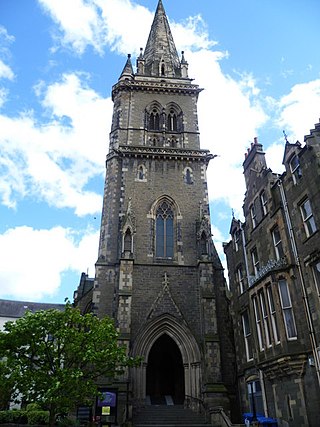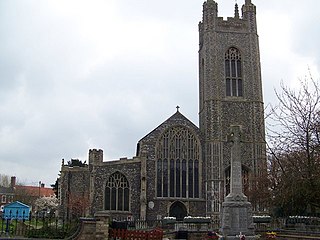
Clare is a market town on the north bank of the River Stour in Suffolk, England. Clare is in southwest Suffolk, 14 miles (23 km) from Bury St Edmunds and 9 miles (14 km) from Sudbury. Clare won Village of the Year in 2010 and Anglia in Bloom award for Best Large Village 2011 for its floral displays in 2011. In March 2015, The Sunday Times and Zoopla placed Clare amongst the top 50 UK rural locations, having "period properties and rich history without the chocolate-box perfection – and the coach trips".

St. Paul's Cathedral is an Anglican cathedral in the city of Dundee, Scotland. It is the cathedral and administrative centre of the Diocese of Brechin in the Scottish Episcopal Church.

Highnam is a village and civil parish on the outskirts of the city of Gloucester. It is three miles northwest of the city on the A40, on the way to Ross, west of Alney Island and Over Bridge. It is connected by Segregated Bicycle Paths via Over Bridge and Alney Island to Gloucester. The parish includes the villages of Lassington and Over. In the 2001 census the parish had a population of 2,014, reducing to 1,916 at the 2011 census. At the 2021 census it had increased to 2,141.

Belchamp St Paul is a village and civil parish in the Braintree district of Essex, England.

St Peter's Church is in Chapel Street, Congleton, Cheshire, England. It is recorded in the National Heritage List for England as a designated Grade I listed building. It is an active Anglican parish church in the Diocese of Chester, the archdeaconry of Macclesfield and the deanery of Congleton. Its benefice is combined with those of St Stephen, Congleton, St John the Evangelist, Buglawton, and Holy Trinity, Mossley. Alec Clifton-Taylor includes it in his list of 'best' English parish churches. The Church Buildings Council included St Peter's in its group of 300 Major Parish Churches following research produced in 2016. [Pursell 2016]

St Hildas Church is the parish church of Hartlepool, County Durham, England. It is recorded in the National Heritage List for England as a designated Grade I listed building. The church is located in Old Hartlepool on the Headland. It is one of the many visible buildings on Hartlepools skyline.

Ufford is a village and civil parish in Suffolk, England. Its population of 808 at the 2001 census rose to 948 at the 2011 Census and was estimated at 1,008 in 2019. The village lies 2 miles south-south-west of Wickham Market and 13 miles north-east of Ipswich. The main road through the village was renumbered B1438 after its replacement as a trunk road by the new A12.

Cretingham is a village and a civil parish in the East Suffolk district, in the English county of Suffolk. It is on the River Deben, 2 miles south off the A1120 road. It is four miles west from Framlingham and eight miles northwest from Woodbridge.

St Mary the Virgin's Church is a redundant Anglican church in the village of Stonham Parva, Suffolk, England. It is recorded in the National Heritage List for England as a designated Grade I listed building, and is under the care of the Churches Conservation Trust. The church is sited 10 miles (16 km) north of Ipswich, to the west of the A140 road.

St Mary's Church is a redundant Anglican church in the town of Bungay, Suffolk, England. The church and the ruins of the adjacent priory are recorded in the National Heritage List for England as a designated Grade I listed building, and are under the care of the Churches Conservation Trust. The church stands in the centre of the town on St Mary's Street, the A144 road.

Preston Minster, formally the Minster Church of St John the Evangelist, is in Church Street, in the centre of Preston, Lancashire, England. From its origin it has been the parish church of Preston. It is an active Anglican church in the deanery of Preston, the archdeaconry of Lancaster and the diocese of Blackburn. Its benefice is united with that of St George, Preston. St John's is recorded in the National Heritage List for England as a designated Grade II* listed building.

St Edmund's Church, Southwold is a Grade I listed parish church in the Church of England in Southwold, Suffolk.

St Mary's Church is a Grade I listed parish church in the Church of England in Kersey, Suffolk.

St Peter and St Paul's Church, Aldeburgh is a Grade II* listed parish church in the Church of England in Aldeburgh, Suffolk.

St Mary's Church is a Grade I listed parish church in the Church of England in Mildenhall, Suffolk.

St Mary the Virgin's Church, Cavendish is a Grade I listed parish church in the Church of England in Cavendish, Suffolk.

St Maurice's Church, Winchester was a parish church in the Church of England in Winchester, Hampshire.

A Wool town is a name given to towns and villages, particularly in Suffolk and north Essex, that were the centre of the woven cloth industry in the Middle Ages.

The Church of St Michael and All Angels is a Church of England parish church in Cookley, Suffolk. The church is a grade I listed building.

The Suffolk Guild of Ringers for the Diocese of St Edmundsbury and Ipswich is a society and charity supporting the bell ringers and rings of bells in the Diocese of St Edmundsbury and Ipswich who practice the art of change ringing. The Guild was established on 2 April 1923 at Ipswich and covers over 200 rings of bells in the county of Suffolk in the area that falls within the diocese boundary.
























